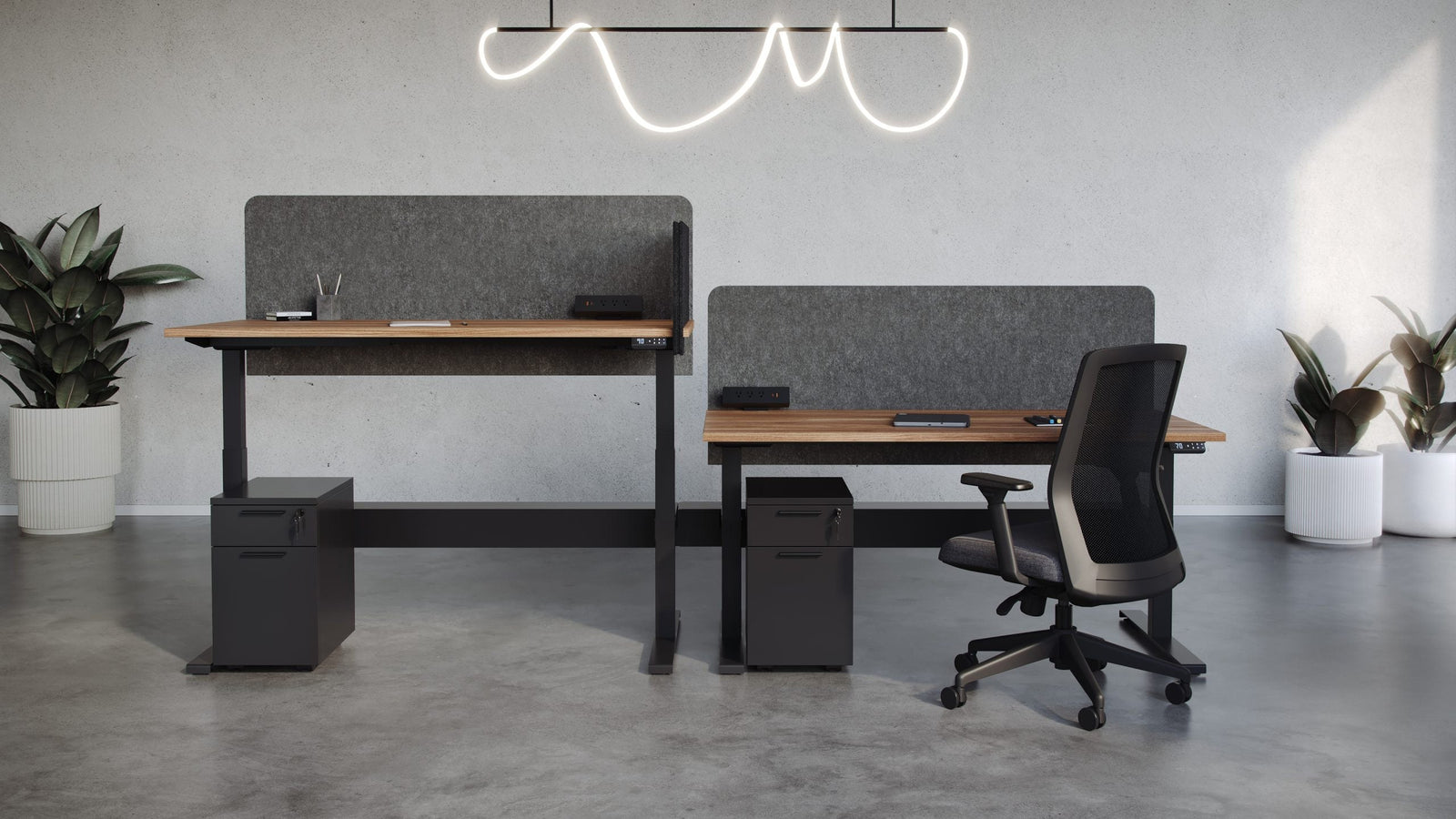Office furniture has evolved considerably in recent years, particularly with the rise of teleworking and the growing awareness of the impact of a sedentary lifestyle on health. Among the most popular innovations, the height-adjustable desk has become an essential ergonomic solution. It allows you to alternate between sitting and standing, promoting comfort and productivity at work. But what are the real benefits of these desks, and how do you choose the right one? This article explores in depth the benefits of an adjustable desk and guides you to optimize your workspace.
1. Improving health and well-being at work
Sitting for long hours can lead to a variety of health problems, including back pain, poor circulation and an increased risk of cardiovascular disease.
Reduced back pain
One of the main benefits of an adjustable desk is the reduction of back pain. By enabling users to change position regularly, it helps relieve pressure on the spine and improve posture.
Better blood circulation
Alternating between sitting and standing stimulates blood circulation, reducing the risk of thrombosis and heavy legs. Better circulation also contributes to higher energy levels throughout the day.
Reducing the risks associated with a sedentary lifestyle
Studies show that sitting too long increases the risk of obesity, type 2 diabetes and cardiovascular disease. The use of an adjustable desk helps reduce these risks by encouraging a more active way of working.
2. Increase productivity and concentration
An ergonomic work environment not only improves health, it also boosts employee concentration and performance.
More energy and less fatigue
Working intermittently in a standing position helps combat fatigue and maintain a more constant energy level. Less fatigue also means better concentration.
Improved creativity and collaboration
In collaborative work environments, an adjustable desk can facilitate standing exchanges and meetings, promoting better team dynamics and faster decision-making.
Read more: The impact of office design on employee productivity
3. How to choose the right adjustable desk?
With the rise of these desks, the range on the market is vast. Here are the essential criteria to consider when making an informed choice.
Type of mechanism
- Manual desk: Less expensive, but requires effort to adjust height.
- Electric desk: More ergonomic, with smooth, often memorized adjustments.
Adjustment range
A good adjustable desk should cover a sufficient height range to suit all users, whether tall or short.
There are two main types of adjustable desk bases:
- Double-extension bases: These models offer a smaller adjustment range, and are generally suitable for people who primarily wish to work standing up. They are often more affordable due to their simplified design.
- Triple-extension bases: Offering a wider range of adjustment, these models enable shorter people to work comfortably in a seated position, while providing sufficient height for taller people, both seated and standing. Although more expensive, these desks guarantee optimum flexibility and enhanced comfort.
Digital control
Digital control is another key element to consider. A good control system should offer at least three adjustable memories for storing predefined heights for sitting, standing and half-height work. This enables the desk to be adjusted quickly and precisely to the user's preferences, improving ergonomics and efficiency at work.
Stability and robustness
Choose a model with good stability, especially in the upright position, to avoid any discomfort or unwanted movement when typing.
A good adjustable desk should also be equipped with a number of safety and durability features:
- Anti-collision sensor: This sensor automatically stops the movement of the desk when it detects an obstacle, thus avoiding any risk of damage to furniture or accidents. This is particularly important in telecommuting environments where children could manipulate the desk control.
- Gyroscopic sensor: This device ensures a perfectly balanced fit between the two base legs, guaranteeing smooth ascent and descent without tilting.
- Reinforced steel structure: A good table should incorporate a steel structure connecting the two legs below the surface. This design greatly enhances stability and prevents the tabletop from warping over time.
- Leveling glides: Located on each of the base legs, these glides enable precise leveling of the desk, guaranteeing optimum stability even on slightly uneven floors.
Surface and design
Opt for a spacious tabletop that accommodates all your equipment (screen, keyboard, accessories) while blending harmoniously into your working environment.
Cable management
Often overlooked, cable management is essential for an organized and functional office. A good cable management system not only enhances the aesthetics of the workstation, but also simplifies access to connections and prevents wire clutter.
- Cable management basket or net: Easily attached to the underside of the desk surface, this allows wires to be grouped together, and a power bar or battery to be placed in it for more convenient access.
- Screen stand with integrated cable management: A single or double articulated arm frees up desk space, adjusts the screen to the right height and conceals cables for a sleek look.
- Cable trunking and cable ties: Simple solutions that help direct and hold cables in place, preventing them from dragging across the floor or becoming tangled.
Good cable management contributes to better organization and a safer, more ergonomic working environment.
Standards and warranties
It's important to ensure that your office meets recognized standards of quality and durability, such as :
- ANSI/BIFMA: Guarantees the safety and robustness of office furniture.
- LEVEL 2: Certification that assesses the environmental sustainability and impact of the product.
- GreenGuard: certifies that the office complies with strict standards in terms of chemical emissions, thus contributing to a healthy indoor environment.
In addition to these certifications, look for a desk offering a comprehensive warranty, covering not only the structure but also electronic parts, such as the motor and control panel for electric models. An extended warranty is often an indicator of product quality and durability.
Read more: Bifma, Level and Greenguard standards: Let's demystify them together!
4. Tips for using an adjustable desk
Having an adjustable desk isn't enough: you also need to use it correctly to get the most out of it.
Change positions regularly
We don't recommend standing for too long either. Alternate every 30 to 60 minutes between sitting and standing to maximize the benefits.
Adapt the height to your morphology
When seated, your elbows should be at a 90° angle to the desk. When standing, the screen should be at eye level to avoid neck strain.
Use an anti-fatigue mat
An ergonomic mat can improve standing comfort and reduce pressure on feet and legs.
Complement with an ergonomic chair
The use of an ergonomic office chair with good lumbar support remains essential for those moments spent in a seated position.
À lire: How to choose your office chair?
In conclusion
Adopting a height-adjustable desk means investing in your health, well-being and productivity. By allowing you to alternate between different postures, it helps prevent pain, improve circulation and boost concentration. To get the most out of it, it's essential to choose it carefully and use it optimally. Would you like to integrate an adjustable desk into your workspace? Solutions M3 can help you choose the right ergonomic furniture for your needs.


